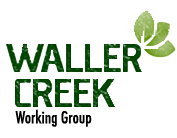The FRI’s Urban Ecosystem stream has a purpose of assessing the relations, health, and values of green spaces within cities. We focus on the health of city environments so that it may be easier for policy makers and other influencers to make important decisions based on concrete, relevant, and reliable data. The Habitat Assessment team, the branch of the UE stream in which I am a part of, has a goal to help shape the value of our urban ecosystems. We want to be able to take the greenery from cities and turn it into more than just grass and a park, but rather an investment for the health of our communities. My team and I plan to establish the economic value for formal and informal green spaces around cities. Formal green spaces are vegetated areas with a name and an aesthetic and recreational value. For instance, a few formal locations are Zilker Park, Waller Creek, and Peace Park. Informal green spaces are areas covered in vegetation with no specific label or purpose, such as the green patches in parking lots or vacant lots. We hope that the data and conclusions we form will be able to be applicable to more than just Austin, but also cities with similar environments to Austin and maybe even cities in general. Potentially, our research will help cities establish a value for the formal and informal green spaces in their financial budgets. The mowing of green belts, maintenance of trees and bushes, and watering of greenery all cut into a city’s budget, and with our research city officials will be able to acknowledge the worth of it all.
Below is a picture of one of my group members, Sonakshi, holding up a leaf of a tree. This was taken at Eastwood Park, where my group and I went to practice and perfect our methodologies for our upcoming research. We worked in the Northwest quadrant of the park at around 11:30 on Saturday February 23rd. The weather was perfect; it was 68℉, sunny, and wind speeds were about 16 mph. The methodologies we worked on were tree inventory, inflorescence, and bird count. These are only a few of the methodologies we will be working on this spring. The full list can be found in the link below. Tree inventory consisted of us taking note of the circumference of the trees at breast-height and listing characteristics of the trees in hopes of identifying what species of trees were present in Eastwood Park. We recorded a variety of tree trunk circumferences ranging from 3.5 ft CBH (Circumference at Breast-Height) to 7.5 ft CBH. My team and I had a difficulty identifying each trees, so we recorded pictures and details in our lab notebooks so that we may go back and identify the tree species. Although we were unable to identify exact species, we definitely did see a wide variety of trees in a relatively small area. In addition to identifying trees, we also took inflorescence counts, which was consisted of us counting the number of angiosperms and gymnosperms in the park. We counted 6 flowered plants and 23 non-flowered plants, which also included a few weeds along the way. Bird count was tricky because birds are still in migration due to the current season, but we did our best to practice this experiment. We sat on the park’s swings and waited for about 10 minutes, and in that time we only heard birds, but as we walked the park trail we saw a couple sparrows out of the quadrant in which we chose to collect data from. For many of these methodologies, we use pamphlets and naturalist guidebooks to help us identify the species we come into contact with in the field, such as birds, trees, insects, flowers, and more. Our pamphlets allow us to have a hands-on resource and approach to our research, which can also help us appreciate the work we do more.
-Angela Lopez

